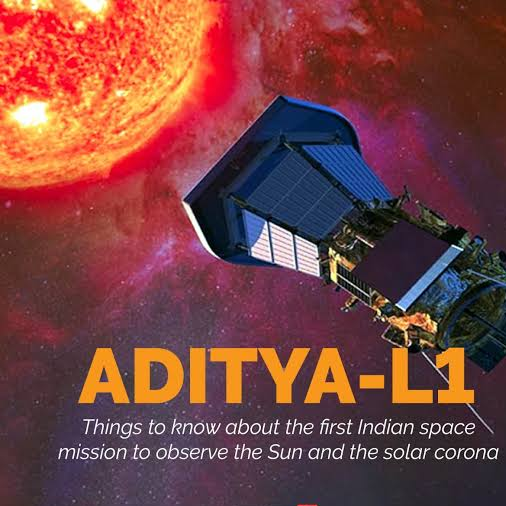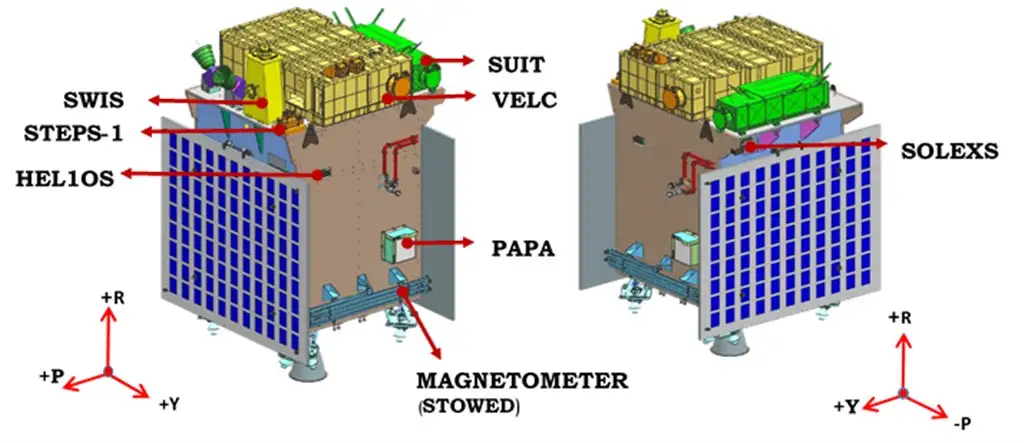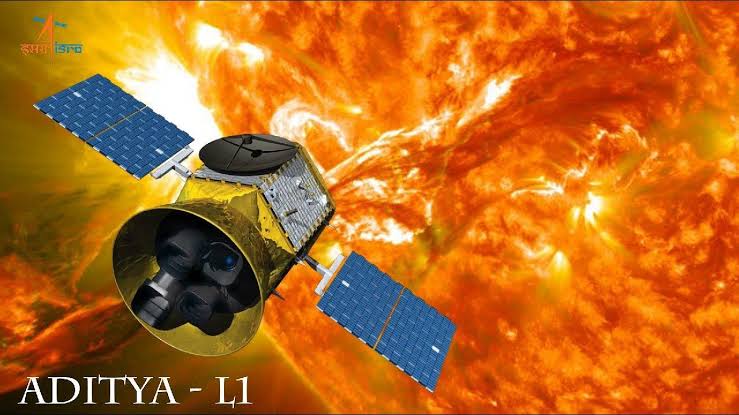Aditya L1 is India’s first solar mission, named after the Hindu sun god Aditya. It is a space-based observatory that will be placed in a halo orbit around the first Lagrange point (L1) of the Sun-Earth system. L1 is a point in space that is located directly between the Sun and the Earth, and it is about 1.5 million kilometers from Earth. This position gives Aditya L1 a unique vantage point to study the Sun, as it will be able to view the Sun continuously without any occultation or eclipses.
The enigmatic solar atmosphere, comprising the chromosphere and corona, holds the key to unraveling the mysteries of our nearest star. In an ambitious endeavor, cutting-edge technology and scientific curiosity have converged to launch a groundbreaking mission that promises to revolutionize our understanding of the Sun’s outer layers. Equipped with seven state-of-the-art payloads, this mission will not only observe the solar atmosphere remotely but also conduct in-situ measurements at the vantage point of L1.

Remote Sensing: Peering Into the Sun’s Veiled Layers
Four of the payloads on board this remarkable mission are dedicated to remote sensing of the Sun. They possess the capability to capture invaluable data and images from a distance, shedding light on the intricate workings of the chromosphere and corona.
By harnessing the power of advanced instruments, scientists will delve into the chromosphere, the middle layer of the solar atmosphere. This region, sandwiched between the Sun’s surface and the corona, is a hotbed of activity. It is here that solar flares and prominences take shape, emanating mesmerizing bursts of energy into space. The remote sensing payloads will enable us to scrutinize these phenomena, providing a deeper understanding of their origins and mechanisms.
Furthermore, these cutting-edge instruments will gaze beyond the chromosphere, penetrating the enigmatic realm of the corona. The corona, a halo of plasma that surrounds the Sun, emits an ethereal glow during a total solar eclipse, captivating skywatchers around the world. Remote sensing technology will now grant us unprecedented access to this celestial spectacle, unraveling its intricacies and unraveling long-standing puzzles surrounding coronal heating, solar winds, and magnetic field dynamics.
In-Situ Observations: Local Insights at L1
Complementing the remote sensing payloads are three instruments specifically designed for in-situ observations. Positioned at L1, a gravitational balance point between the Sun and Earth, these instruments will capture a snapshot of the local solar environment, providing critical data for comprehensive analysis.
At this advantageous vantage point, scientists will be able to gather real-time information about the conditions prevailing in the solar atmosphere. By directly measuring plasma properties, magnetic fields, and energetic particles, these in-situ payloads will offer invaluable insights into the dynamic nature of the Sun’s outer layers. Such data is crucial for validating and enhancing our understanding of the remote sensing observations, bridging the gap between theory and reality.
A New Chapter in Solar Science
This extraordinary mission, with its array of seven payloads, represents a new chapter in solar science. By integrating remote sensing and in-situ observations, it aims to unlock the secrets of the chromosphere and corona, shedding light on the fundamental processes that drive our Sun and influence space weather.

The knowledge gained from this ambitious endeavor will not only deepen our understanding of the Sun but also enable us to predict and mitigate the impact of solar activity on Earth’s technological infrastructure. As we embark on this cosmic journey, we invite you to join us in exploring the awe-inspiring beauty and scientific wonders that await us in the captivating realm of the solar atmosphere.
Aditya L1 is India’s first solar mission, named after the Hindu sun god Aditya. It is a space-based observatory that will be placed in a halo orbit around the first Lagrange point (L1) of the Sun-Earth system. L1 is a point in space that is located directly between the Sun and the Earth, and it is about 1.5 million kilometers from Earth. This position gives Aditya L1 a unique vantage point to study the Sun, as it will be able to view the Sun continuously without any occultation or eclipses.
The Aditya L1 mission has a number of scientific objectives, including:
- Studying the solar corona, the outermost layer of the Sun’s atmosphere
- Understanding the physics of solar flares and coronal mass ejections (CMEs)
- Investigating the origin and dynamics of the solar wind, the stream of charged particles that flows from the Sun into space
- Studying the effects of solar activity on Earth’s atmosphere and climate
The Aditya L1 spacecraft is equipped with seven scientific instruments, which will be used to carry out these investigations. The instruments include:
- A coronagraph, which will block out the bright light of the Sun’s disk so that the faint corona can be studied
- A spectrograph, which will be used to study the composition and temperature of the solar corona
- A magnetometer, which will be used to measure the magnetic field of the Sun
- A particle detector, which will be used to study the charged particles that flow from the Sun
The Aditya L1 mission is scheduled to be launched in July 2023. It is expected to operate for a period of five years.
Here are some other interesting facts about the Aditya L1 mission:
- The spacecraft is named after Aditya, the Hindu sun god.
- The mission’s logo features a stylized image of Aditya, with the seven scientific instruments represented by the seven rays of the sun.
- The Aditya L1 spacecraft is the first Indian spacecraft to be placed in a halo orbit around L1.
- The mission is expected to cost around ₹1,500 crores (US$200 million).
The Aditya L1 mission is a significant step forward for Indian space exploration. It will be the first Indian spacecraft to study the Sun in detail, and it will provide valuable insights into the workings of our nearest star.

